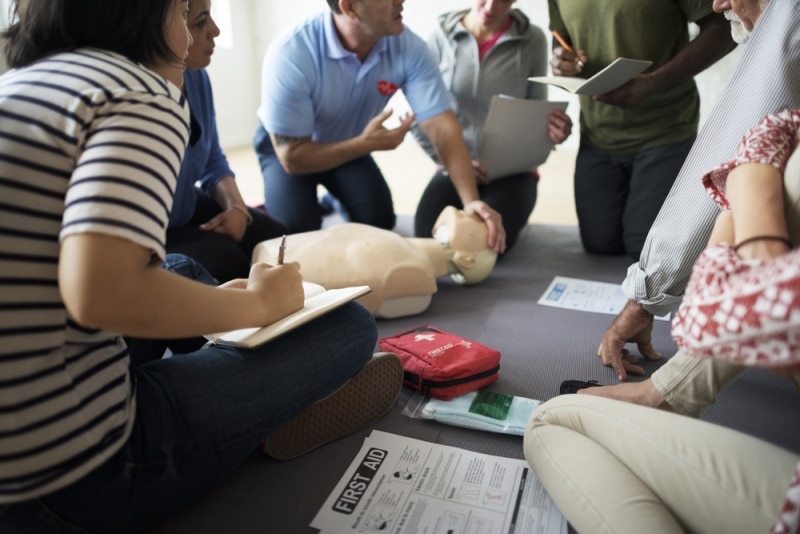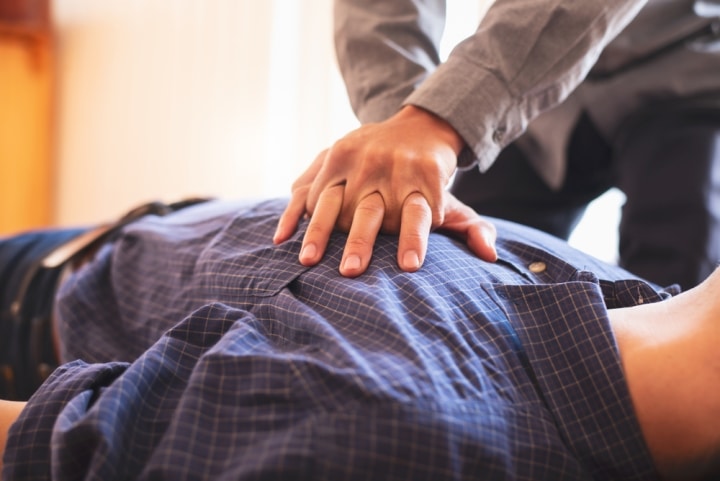Does your job require you to become CPR certified? Are you interested in CPR certification so that you are better able to help in an emergency?
If so, you may have questions about how you become CPR certified. And we have answers! Let’s take a look at the CPR certification process, from how to find and choose a class to what to expect once you begin.
Why get CPR certified?
Before we examine the CPR certification process, let’s quickly review why you might be seeking one in the first place.
CPR certification classes will help you to know what to do in the event of a cardiac arrest, and generally provide first aid training and an understanding of how to operate an Automatic External Defibrillator (AED).
People get CPR certified for many different reasons. Many jobs require ongoing CPR certification including
- Athletic trainers
- Airline employees
- Healthcare providers
- Police officers
- Doctors
- Nurses
- Security personnel
- Lifeguards
Occupational Safety and Health Administration (OSHA) requires CPR and first aid certification for a number of industries, including logging, electrical power, and construction.
Some people get CPR certified simply because they want to be ready and able to help if they are needed. Teachers, parents, babysitters, coaches, and others often choose to be CPR certified so that they can be prepared for emergency situations if they occur.
The only way to learn CPR and be certified to perform CPR is by taking an accredited CPR certification course and passing the standardized test.
How do I find a CPR certification class?
Depending on where you live, you can find CPR classes in a variety of places. It’s not uncommon for employers to bring in organizations like ours to offer courses to their employees. Similarly, community organizations, schools, churches, and others occasionally offer group CPR classes.
Can I become CPR certified online?
No matter where you live, you can easily find a CPR class online. Online CPR Certification Classes can be taken online using your computer or mobile device instead of a classroom. Class instruction is given through written course material, illustrations, video, and interactive prompts.
As we’ve discussed in our blog:
“The choice to take your CPR certification course online or in a classroom is a personal decision. Some individuals are better suited to learning in a classroom. However, most students do better with online based classes.
One of the greatest benefits of online classes is that you can take the class at your own pace. You can start, stop and skip around as much as you like. In addition, you can take the class whenever you like.”
Finding an accredited class to get CPR certified online is as easy as clicking a link. Online CPR training can provide high-quality instruction and a pathway to your certification card. Just complete the online training, pass the test, and you are ready to help.
What should I expect in a CPR certification class?

Expectations for an online CPR class should be different from those of an in-person class, but there are many things they have in common. We’ll look at these shared characteristics first, then touch on a few key differences.
In any accredited CPR class, which are often taught by professional rescuers (often paramedics), you should expect to learn the basics of First Aid, Cardiopulmonary Resuscitation, and the use of an Automated External Defibrillator. You will learn how to perform chest compressions following the most current guidance from the American Heart Association.
After some introductions, your instructor will guide you through a curriculum approved by the American Heart Association. This will generally include training on
- CPR
- AED
- Choking (Heimlich Maneuver)
- EMS
- First Aid Basics
- Medical Emergencies
- Trauma
- Bleeding
- Amputations
- Poisoning
- Environmental Dangers and Considerations
You will be taught how to recognize cardiac arrest and how and when to provide chest compressions. You will learn about rescue breathing and what current research tells us about when to use it. You will learn basic first aid. You will also learn and be able to practice the actual sequence of using an AED.
Regardless of whether you are learning online or in person, you should expect your class to be taught in a combination of teaching modalities. These will generally include written course material, video, live demonstrations, and interactive discussions.
In an in-person class, you may have the opportunity to practice CPR skills on a mannequin, and to be assessed on your performance. If a hands-on skill demonstration is required by your employer or industry, AED CPR can provide one to your home or office for our online courses.
Once you have completed the classroom training (in person or online), you will complete a standardized test approved by the American Heart Association. Passing this test will certify you to perform these skills, and provide your employer with the credentials they require.
At AED CPR, we offer our online CPR certification courses for free, and you’ll pay only for the certification exam at the end.
How long does it take to get CPR certified?
An in-person CPR certification class takes anywhere from three to nine hours to complete. It will vary based on the options available for the course (are you also learning infant and child CPR, for example), what type of course it is, and how many people are in the class.
An online CPR certification class can be completed on your own timeline. If you are a quick study, or already have some basic understanding of CPR, it may take less than an hour. If you need to stop, start, come back to material, or review a section it is completely possible with an online course, but the completion time may take longer.
Renewing your CPR certification is just as quick, and online courses provide the same flexibility.
All of this means that there is no reason for you to delay. Get CPR certified today!

